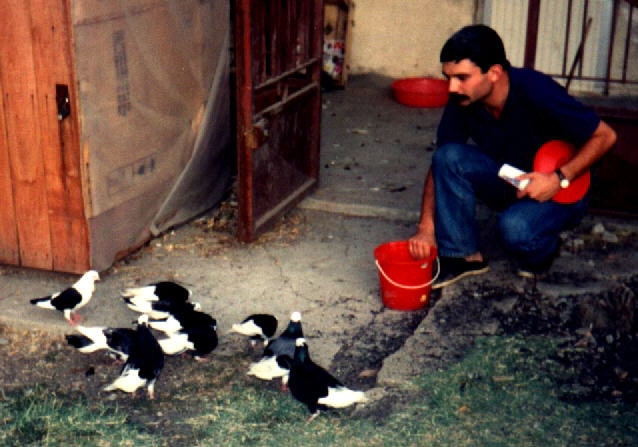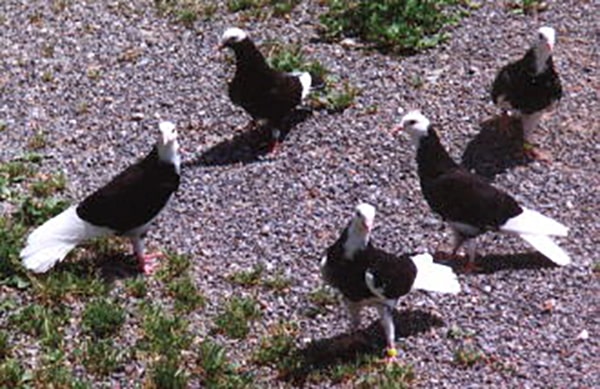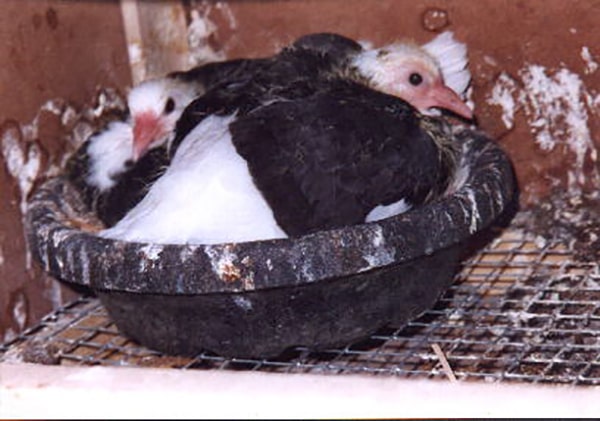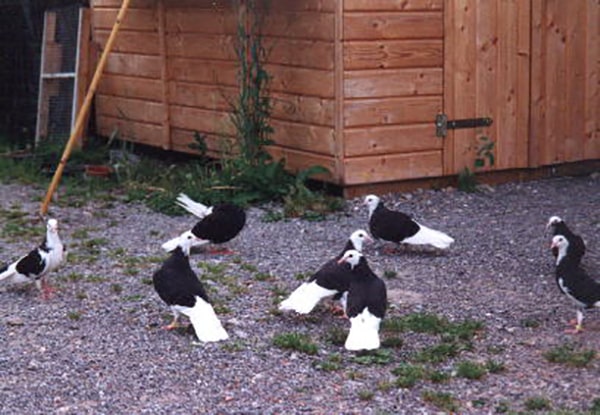
DÖNEK
Professor Türker Savaş with his döneks. (Bird on the top left corner is a Bango.)
Dönek is a medium size breed but, can be considered tall compared to most breeds. It's main tail feathers in general are longer and wider than common pigeon breeds. Most of them also have the tail in a mild (up-side-down) "V" shape but, not as obvious as in Kelebeks. Döneks carry their wing above the tail in a resting fashion. Wings are to be pointy at the tips and the wing span opens up to be longer than the average. The beak is longer than medium standard. They stand parallel to the ground on their moderately short legs. Döneks raised in Turkey do not come with any head decorations and are clean legged. The ones we started to see, last few years, with full or half leg feathering are mainly cross bred with Macedonia (Yugoslavia) Döneks.
Döneks carry self, grizzled and pied color patterns and come in every color possible. The most common color and pattern combinations for this breed are bold head in self colors, white flights and bald head in selfs, and bald head and white flights with white tail. Most common color with these patterns is black and followed by blue and checkers. Least common or most rare is the pied recessive red color combination. In the region of Izmir, bald head and white flight pattern is named "Baska" and if the white tail is also present named "Galaça". These terms are used together with the color of the bird as in "black Baska" or "blue Galaça" to describe the bird. Recessive reds are named "Çakal" (Which essentially means jackal) regardless of being self color or pied.
The main eye color is black however; besides the wild eye color, it is possible to run into any color. Döneks reach maturity or adulthood later than most other breeds and their parenthood skills seems to be less than homers or dewlaps. It is common to see clear developmental difference between the two young in the nest. As a final note, this breed is more sensitive towards "trichomonad" and "paramyxovirus" type of sickness.
Group of Döneks hanging out with Bursa rollers (w/o baldhead), Bangos (black shields) & Thrace rollers (yellow and red).
POPULARITY IN TURKEY
Dönek is mainly bred in Western Turkey. Even though, it is not the most common breed even in this region, in some cities it is the only breed that is raised. As the most Dönek breeders live in the city of Izmir, this city is followed by Bursa in the north-west and Denizli in the south-west. However, in Denizli Dönek is the sole breed that is kept. Most of the breeders in the cities of Izmir and Bursa are made out of migrants out of Balkans. Besides these cities on the Aegean Sea cost there are many small towns such as Ayvalık, Malkara and Keşhan in Trakya region that primarily keeps this breed. In Istanbul, where every breed is present, there are also some fanciers that focus on Dönek but, they are few in between.

FLIGHT
As they are let to fly, döneks rapidly gain altitude. When a dropper flashed, they dive towards ground and spin with the tip of one wing and that corner of the tail as the center of the propelling action. Main goal of the breeders is to get the most possible spins in highest speed. During the spin, the position of the wings changes for different birds. Some completely close their wings in during the spin and most of them keep the wing quarter open. There are also some that do the opposite of others and stretch their wings as wide as possible. Looking from the side view each spin is easily visible and clear, unlike rollers, when one turn stops and the other starts, even in the fastest birds is obvious.The best dives happen in 45 degrees to Earth and any variation from this will affect the quality of dive negatively.
TRAINING
Even though they behave skittish in the coop, it is a very easy breed to control. If there are few birds on the ground, it would make it difficult to get them airborne. They would rather lounge around. With a stick, group of döneks can be herd to places they have not been to before. They will stick together and just follow the directions. As long as they are not scared, they wont fly. However, because of this behavior, one should not think they are lousy fliers.
Young birds can be trained to fly earlier than most breeds. In their first flight, the young birds can take up to sky with adults. Because of this, it is important to pay attention to one thing: They might go as high as the adult birds go but, when the dropper is shown, will not be able to get down as quickly as them. Since it is their first flight and they are not familiar with the surroundings, they will easily get lost. Specially, if there are other birds around. Even doves or wild pigeons will cause them to get confused. If this happens the adult birds should not be allowed to land and if possible, more birds should be flown to get their attention.
Bottom line, the young birds should not be allowed to get to high or far. For this purpose, they can be trained with other breeds that fly in low altitudes for short periods but, this might not be enough to keep them focused if the wild air traffic is heavy. Another way to train young with less risk of loosing them is basically to start their training late. If they are trained after 8 or 10 weeks of age, their sense of location abilities will be much better and also, they will be more familiar with the surroundings, even if it is only from ground view. In most breeds training late reduces the quality of flight or performance a great deal. In fact, to get the 8 to 10 weeks fly compared to 5 to 6 weeks is almost impossible in some breeds.
As long as they are kept in good shape, there will be no negative effects of late training with döneks for flight, in quality of diving or the spinning . It is even for birds that reach adulthood at 20-22 weeks of age very easy to train.


However, it is very important to pay attention to their diet and prevent them from getting over-weight. Just like all the other performing breeds, in this breed the feed must be limited. Extra weight, even with the best performers, will affect the quality of dive and spin negatively. In my opinion the best way to feed this breed is to get the amount of feed they will eat in one meal (within once a day feeding program) and divide that amount into 1/3 to be fed in the morning and 2/3 to be fed afternoon. Flying birds should be mainly fed with wheat and occasionally in very low quantities a high-quality feed mixture can be added. Once the birds are used to flying around the loft, the dive and spin training can start:
The bird to be trained has to be flown with an experienced bird. When both birds reach an altitude desired, they are in a 45-degree position to coop and the wind is behind them, first their attention has to be pulled to ground by using a whistle, whistling, clapping, waving hand or flag. After few training flights this signal will mean "get ready for a dive" for the young bird. Soon after this a dropper should be shown to get the experienced bird to dive. Soon the young bird will start to follow the diver.
Flying more then two birds, even if they fly together, will make it more difficult to get the group in a good position for the dive. Since, regardless of where they are in the air, they will react to the dropper, the proper dive and spin can not be achieved. Some breeders use a method of flying the bird to be trained alone. Advantage of this; it makes it very easy to control the trainee. Disadvantage of it; can be used to train for short dives since the bird does not reach a high altitude alone.During training, it is crucial to signal the birds and get them to look at the dive location before showing the dropper. The quality of dive and the spin is greatly affected from this.
It is also very important where the trainer stands during the flight. Trainer must be in a location where he can clearly view the birds and the birds can clearly see him at all times. Waiting in a location not clearly visible for the birds and getting out into open to wait for them to get into position is worthless. Only thing this will do for the trainer is to get him to be the "get ready for a dive" sign. As soon as the trainer becomes visible, birds get ready to dive. In some cases, they will actually start their dive. This takes a way from the most important factor of the dive the positioning. Always be visible and use your "get ready to dive" sign.
Dr. Türker Savaş
